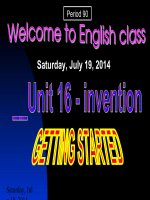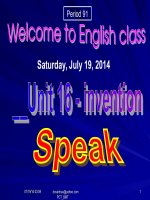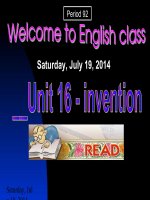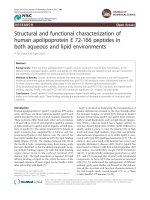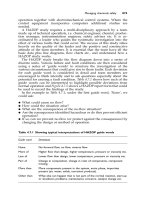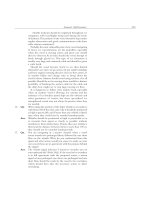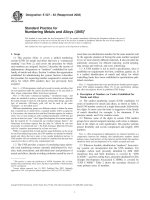Astm e 1010 16
Bạn đang xem bản rút gọn của tài liệu. Xem và tải ngay bản đầy đủ của tài liệu tại đây (79.82 KB, 4 trang )
Designation: E1010 − 16
Standard Practice for
Preparation of Disk Specimens of Steel and Iron by
Remelting for Spectrochemical Analysis1
This standard is issued under the fixed designation E1010; the number immediately following the designation indicates the year of
original adoption or, in the case of revision, the year of last revision. A number in parentheses indicates the year of last reapproval. A
superscript epsilon (´) indicates an editorial change since the last revision or reapproval.
1. Scope
controlled rate of flow. An arc is struck between the electrode
and the sample material and is maintained until the melting is
complete. The molten specimen is allowed to solidify in the
crucible in an argon atmosphere. After solidification, the
specimen is removed from the crucible and prepared for
spectrochemical analysis.
1.1 This practice describes the preparation of disk specimens of steel and iron by melting chunks, chips, drillings,
turnings, wire, or powder briquets with an electric arc in an
argon atmosphere. Solidification of the specimen takes place in
the crucible in an argon atmosphere. The disk obtained is
suitable for quantitative spectrochemical analysis.
4.2 Partial losses of some elements may be experienced
during the melting of the disk specimen. This procedure, if
carefully followed, will provide consistent losses. Elemental
losses can be determined by correlating the analysis of the
charge material with the spectrochemical analysis of the
remelted specimen.
1.2 The values stated in SI units are to be regarded as
standard. No other units of measurement are included in this
standard.
1.3 This standard does not purport to address all of the
safety concerns, if any, associated with its use. It is the
responsibility of the user of this standard to establish appropriate safety and health practices, and determine the applicability of regulatory limitations prior to use. Specific warning
statements are given in 6.2.1, Section 8, and 10.1.2.1.
5. Significance and Use
5.1 Most spectrochemical instruments employed for analyzing steel and iron require a solid specimen with a flat surface
large enough for analytical excitation and measurement procedures. This practice describes a procedure for converting
unusual types of steel and iron samples to satisfactory spectrochemical specimens.
2. Referenced Documents
2.1 ASTM Standards:2
E135 Terminology Relating to Analytical Chemistry for
Metals, Ores, and Related Materials
E876 Practice for Use of Statistics in the Evaluation of
Spectrometric Data (Withdrawn 2003)3
6. Apparatus
6.1 Melting Furnace,4consisting of a chamber that contains
the following:
6.1.1 Crucible, of copper and water-cooled, in which
samples of steel or iron are melted, then solidified to form
specimens for spectrochemical analysis.
6.1.2 Electrode Holder, water-cooled and of negative
polarity, that can be moved up and down easily, and may have
provisions for circular motion and adjusting the arc gap to a
fixed spacing.
6.1.3 Viewing Window, composed of dark welding-type
glass with an inner-protective glass that is impervious to heat
and splatter from the molten metal.
3. Terminology
3.1 For definitions of terms used in this procedure, refer to
Terminology E135.
4. Summary of Practice
4.1 The sample of steel or iron is placed in a water-cooled
copper crucible. The furnace is flushed with argon at a
1
This practice is under the jurisdiction of ASTM Committee E01 on Analytical
Chemistry for Metals, Ores, and Related Materials and is the direct responsibility of
Subcommittee E01.01 on Iron, Steel, and Ferroalloys.
Current edition approved Jan. 15, 2016. Published March 2016. Originally
approved in 1984. Last previous edition approved in 2009 as E1010 – 09. DOI:
10.1520/E1010-16.
2
For referenced ASTM standards, visit the ASTM website, www.astm.org, or
contact ASTM Customer Service at For Annual Book of ASTM
Standards volume information, refer to the standard’s Document Summary page on
the ASTM website.
3
The last approved version of this historical standard is referenced on
www.astm.org.
6.2 DC Electric Power Generator, to supply electric current
and voltage equivalent to that required for electric arc welding.
It may be a rotating dc generator or a static rectifier with
provisions to adjust the current in the 0 A to 600 A range.
4
Melting furnaces, manufactured by Cianflone Scientific, 228 RIDC Park West
Drive, Pittsburgh, PA 15275, , have been found suitable
for this purpose.
Copyright © ASTM International, 100 Barr Harbor Drive, PO Box C700, West Conshohocken, PA 19428-2959. United States
1
E1010 − 16
TABLE 1 Precision for Remelts of Low-Alloy Steels
6.2.1 Warning—A safety interlock shall be provided to
prevent electrical shocks to the operator when the melting
furnace is open.
Element
6.3 Vacuum Pump, with free air capacity of 50 L/min and
vacuum of 350 µm, minimum.
Si
7. Materials
7.1 Inert Gas, argon of at least 99.96 % purity.
Mn
7.2 Electrode, thoriated tungsten or high-purity graphite.
8. Hazards
Cr
8.1 Operating personnel should adhere to the manufacturer’s operating recommendations to avoid electrical shock and
physical harm from light and heat. See 6.2.1 and 10.1.2.1 for
specific warnings.
Mo
9. Preparation of Samples
Ni
9.1 Remove grease from samples and dry before melting.
Remove other surface contaminates by suitable methods. For
consistent melting, fine powders, chips, drillings, turnings, or
wire may be compacted in a briquetting press with 35-mm die
at a pressure of 2800 kgf/mm2.
Cu
V
10. Preparation of Specimens
Ti
10.1 Place 40 g to 50 g of sample in the crucible. Close the
furnace. The melting of the sample and solidification of the
specimen may vary slightly depending on the design of the
furnace and the type of metal being melted. Two suggested
procedures are as follows:
10.1.1 Procedure A—The following steps are programmed
automatically after pressing the start button: (1) flushing of the
crucible with argon for 30 s, (2) igniting the arc, (3) melting
with the arc for 20 s to 45 s, (4) reduction of arc current from
500 A to 250 A, (5) cooling the specimen in the crucible in inert
gas for approximately 2 min, and (6) indication by light and
buzzer that the melt cycle is completed. When the program is
completed, open the furnace and remove the hot specimen with
magnet or forceps.
10.1.2 Procedure B—Evacuate the crucible to a pressure of
approximately 350 µm of mercury. Flush the furnace with
argon and evacuate. Reflush and evacuate a third time. Shut off
the vacuum pump and flush the furnace with argon. Turn on the
power supply and lower the electrode until an arc is struck to
the sample material (Note 1). Adjust the power supply current
to 500 A. Raise or lower the electrode or move it in a circular
motion to provide uniform melting and melt any particles that
cling to the inside of the chamber. Melt for approximately 1
min, then turn off the power supply and raise the electrode.
Allow the specimen to solidify in the crucible in the argon
atmosphere for approximately 2 min. Open the furnace and
remove the specimen by tilting chamber. Catch the hot specimen in a suitable container.
10.1.2.1 Warning—When melting fine powders, use an
initial current of 100 A until the powders appear to be well
fused. Raise the current to 300 A and complete the melting.
This prevents loss of sample because of splattering of the
powder when the arc is first struck.
Al
P
S
C
Number of
Specimens
Average
Analysis of
Original
Metal, %
Average
Analysis of
Remelts, %
Standard
Deviation
Between
Remelts, %
Relative
Standard
Deviation
Between
Remelts, %
6
6
6
6
6
6
6
6
6
6
6
6
6
6
6
6
6
6
6
6
6
5
6
6
6
6
6
6
6
6
6
6
6
6
6
6
6
6
6
6
6
5
5
5
5
0.283
0.147
0.010
0.098
1.00
0.95
0.074
0.35
0.080
0.044
0.004
0.491
0.022
0.006
0.015
0.153
0.033
0.020
0.402
0.075
0.029
0.015
0.32
0.021
0.036
0.012
0.032
0.002
0.083
0.022
0.004
0.111
0.038
0.013
0.012
0.010
0.010
0.007
0.009
0.024
0.013
0.127
0.219
0.182
0.272
0.277
0.140
0.010
0.097
0.96
0.95
0.076
0.35
0.080
0.046
0.003
0.486
0.021
0.006
0.011
0.155
0.038
0.016
0.403
0.078
0.033
0.022
0.32
0.031
0.035
0.015
0.021
0.002
0.066
0.024
0.003
0.114
0.040
0.013
0.013
0.011
0.010
0.007
0.009
0.023
0.012
0.110
0.220
0.170
0.238
0.010
0.0063
0.0010
0.0042
0.037
0.055
0.0020
0.012
0.0070
0.0023
0.0004
0.0164
0.0012
0.00052
0.00063
0.0105
0.024
0.0017
0.0082
0.0022
0.0019
0.0068
0.0098
0.0081
0.0015
0.00041
0.0037
0.0000
0.0056
0.0025
0.0000
0.00948
0.0039
0.0030
0.0023
0.0000
0.0019
0.0010
0.0016
0.0015
0.0027
0.030
0.048
0.030
0.058
3.61
4.50
10.00
4.33
3.85
5.79
2.63
3.43
8.75
5.00
13.33
3.37
5.71
8.67
5.73
6.77
63.16
10.62
2.03
2.82
5.76
30.91
3.06
26.13
4.29
2.73
17.62
0.00
8.48
10.42
0.00
8.32
9.75
23.08
17.69
0.00
19.00
14.29
17.78
6.52
22.50
27.27
21.82
17.65
24.37
NOTE 1—If the determination of carbon in the specimen is required, use
a thoriated-tungsten electrode. If the determination of tungsten or thorium
is required, use a graphite electrode.
11. Precision and Bias
11.1 Precision:5
11.1.1 Tables 1-3 show the percent standard deviations and
the percent relative standard deviations among disks of various
melted ferrous metals analyzed with both atomic emission
spectrometers and X-ray fluorescence spectrometers. The precision data are included to serve as a guide for the precision
obtainable from melted specimens prepared as described in this
practice. The data were calculated in accordance with Practice
E876.
5
Supporting data have been filed at ASTM International Headquarters and may
be obtained by requesting Research Report RR: RR:E02-1018.
2
E1010 − 16
TABLE 2 Precision for Remelts of Cast Iron
Element
Si
Mn
Cr
Mo
Ni
Cu
V
Ti
P
Number of
Specimens
Average
Analysis of
Original
Metal, %
Average
Analysis of
Remelts, %
Standard
Deviation
Between
Remelts, %
Relative
Standard
Deviation
Between
Remelts, %
6
5
5
5
6
5
5
5
6
5
5
5
6
5
6
5
5
5
6
3
5
5
6
5
5
5
6
5
5
5
6
5
5
5
1.82
0.51
2.10
1.31
0.66
0.53
0.74
0.77
0.15
0.038
0.33
0.093
0.022
0.079
0.09
0.08
1.22
0.07
0.97
0.033
0.038
0.23
0.03
0.032
0.027
0.030
0.05
0.026
0.027
0.04
0.39
0.316
0.024
0.18
1.74
0.47
2.07
1.25
0.71
0.52
0.73
0.76
0.17
0.057
0.36
0.105
0.023
0.079
0.09
0.09
1.20
0.07
0.98
0.040
0.038
0.30
0.04
0.030
0.026
0.032
0.046
0.019
0.021
0.040
0.405
0.336
0.032
0.188
0.029
0.031
0.042
0.029
0.019
0.015
0.022
0.0048
0.012
0.013
0.022
0.0032
0.0010
0.0024
0.0083
0.0077
0.016
0.010
0.019
0.00079
0.0023
0.124
0.0019
0.0014
0.0013
0.00064
0.0059
0.0017
0.0018
0.0027
0.0171
0.0220
0.010
0.0218
1.67
6.60
2.03
2.32
2.68
2.88
3.01
0.63
7.06
22.81
6.11
3.05
4.35
3.04
9.22
8.56
1.33
14.29
1.94
1.98
6.05
41.33
4.75
4.67
5.00
2.00
12.83
8.95
8.57
6.75
4.22
6.55
31.25
11.60
11.1.2 The relative standard deviations among melted specimens can be quite large. The large deviations are due to
element losses or enrichment during melting which can be
minimized by good melting technique, particularly for carbon,
sulfur, and copper. Cleaning the crucible between melts can
reduce contamination errors, especially when widely differing
materials are melted. The physical appearance of the melted
specimens will sometimes be an indication of the homogeneity.
11.2 Bias:
11.2.1 The data in Tables 1-3 show the average analyses for
ferrous metals before melting and for melted specimens. While
the majority of the average analyses of melted specimens
compare favorably with the average analyses of the original
ferrous metals, there are some precautions that need to be
stated concerning this practice:
11.2.1.1 Use of a graphite electrode increases the carbon
concentrations considerably. Thoriated-tungsten electrodes are
recommended when carbon determinations are to be made on
the melted specimen.
11.2.1.2 No statistical determinations were made for tungsten or thorium, however, analyses of the melted specimens
indicate an increase of 0.001 % to 0.03 % tungsten when using
a thoriated-tungsten electrode.
11.2.1.3 Copper enrichment may occur as a result of faulty
technique when using a circular-motion electrode holder.
11.2.1.4 Cast iron samples tend to lose silicon during
melting.
11.2.1.5 The chromium average analysis increases for stainless steel materials when melted.
TABLE 3 Precision for Remelts of Stainless Steels
Element
Si
Mn
Cr
Mo
Ni
Cu
Sn
Pb
Co
P
S
C
Cb
Ta
Number of
Specimens
Average
Analysis of
Original
Metal, %
6
6
6
6
6
6
6
6
6
6
6
6
6
6
6
6
6
6
6
6
6
6
5
5
6
6
0.642
0.472
1.44
1.49
18.91
18.02
0.076
0.30
11.52
11.59
0.185
0.103
0.015
0.011
0.0023
0.0021
0.072
0.144
0.018
0.024
0.018
0.018
0.018
0.032
0.731
0.035
12. Keywords
Average
Analysis of
Remelts, %
Standard
Deviation
Between
Remelts, %
Relative
Standard
Deviation
Between
Remelts, %
0.643
0.470
1.41
1.50
19.00
18.20
0.087
0.30
11.44
11.95
0.192
0.101
0.010
0.009
0.0018
0.0019
0.069
0.149
0.018
0.024
0.017
0.017
0.020
0.040
0.725
0.035
0.014
0.0089
0.0117
0.0075
0.124
0.0884
0.0052
0.0063
0.0663
0.0455
0.0041
0.000
0.0004
0.0016
0.00041
0.0000
0.000
0.000
0.0008
0.0016
0.0012
0.0013
0.014
0.019
0.033
0.000
2.18
1.89
0.83
0.50
0.65
0.49
5.98
2.10
0.58
0.38
2.14
0.00
4.00
17.78
22.78
0.00
0.00
0.00
4.44
6.67
7.06
7.65
70.00
47.5
4.55
0.00
12.1 disk specimen; iron; remelt; spectrochemical analysis;
steel
3
E1010 − 16
ASTM International takes no position respecting the validity of any patent rights asserted in connection with any item mentioned
in this standard. Users of this standard are expressly advised that determination of the validity of any such patent rights, and the risk
of infringement of such rights, are entirely their own responsibility.
This standard is subject to revision at any time by the responsible technical committee and must be reviewed every five years and
if not revised, either reapproved or withdrawn. Your comments are invited either for revision of this standard or for additional standards
and should be addressed to ASTM International Headquarters. Your comments will receive careful consideration at a meeting of the
responsible technical committee, which you may attend. If you feel that your comments have not received a fair hearing you should
make your views known to the ASTM Committee on Standards, at the address shown below.
This standard is copyrighted by ASTM International, 100 Barr Harbor Drive, PO Box C700, West Conshohocken, PA 19428-2959,
United States. Individual reprints (single or multiple copies) of this standard may be obtained by contacting ASTM at the above
address or at 610-832-9585 (phone), 610-832-9555 (fax), or (e-mail); or through the ASTM website
(www.astm.org). Permission rights to photocopy the standard may also be secured from the Copyright Clearance Center, 222
Rosewood Drive, Danvers, MA 01923, Tel: (978) 646-2600; />
4

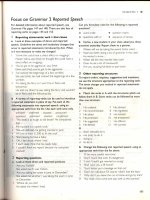
![E:Tuan 16 CKTKN[2].doc](https://media.store123doc.com/images/document/2014_07/04/medium_nkp1382471123.jpg)
